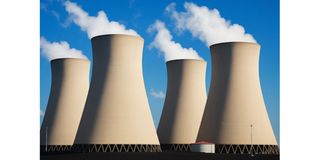Tanzania’s renewable energy ambitions: Progress, challenges, and the role of nuclear energy

Tanzania is charting an ambitious course toward a clean energy future with its National Renewable Energy Strategy 2050, designed to harness the country’s renewable resources while addressing growing energy demands.
As the nation strives to reduce carbon emissions and achieve carbon neutrality, its energy landscape is poised for transformation. However, the pursuit of sustainability is not without challenges, particularly in ensuring energy stability and accessibility.
These challenges underscore the potential of nuclear power as a key component in achieving Tanzania’s energy ambitions.
The National Renewable Energy Strategy reflects Tanzania’s commitment to sustainability, setting clear goals to combat climate change and reduce reliance on fossil fuels.
By 2030, the country aims to lower its carbon dioxide emissions by 45 percent, contributing to global efforts under the Paris Agreement. Plans include developing 750 MW of wind and solar capacity by 2027 and 200 MW of geothermal energy by 2030, with projects strategically located in areas like Kititimo and Makambako.
These initiatives align with Tanzania’s broader industrialisation goals, as outlined in its Third Five-Year Development Plan (2021/22–2025/26). The integration of renewable energy sources aims to reduce environmental impact, increase electricity access, and promote economic growth. However, with only 40 percent of the population currently connected to electricity, achieving universal access remains a formidable challenge.
Tanzania’s energy demand is rising at a rapid pace, projected to grow by 12-15 percent annually. This growth far outpaces the country’s current capacity expansion of 6 percent per year, creating an urgent need for reliable and scalable energy solutions.
Most electricity generation today comes from thermal power plants, which account for about 40 percent of Tanzania’s energy mix. Hydropower, contributing around 60 percent, remains vulnerable to climate change and seasonal variability.
The gap between energy supply and demand is most pronounced in rural areas, where many communities lack stable access to electricity. Dependence on traditional biomass for cooking and heating persists, highlighting the need for affordable and efficient energy alternatives. The lack of energy access has broader implications, affecting education, healthcare, and economic productivity.
Renewable energy sources like solar, wind, and geothermal represent clean alternatives to fossil fuels, offering significant environmental benefits.
However, their intermittent nature poses challenges to reliability. Solar and wind energy, for example, depend on weather conditions, while geothermal projects require significant upfront investments and are geographically constrained.
Tanzania has already made strides in renewable energy, such as launching its first wind farm in Dar es Salaam with a capacity of 2.4 MW. The development of larger projects, including geothermal plants with a planned capacity of 200 MW by 2030, signals progress. Yet, these sources alone cannot meet the country’s growing energy needs.
Incorporating nuclear power into Tanzania’s energy mix offers a pathway to overcoming these limitations. Nuclear energy provides consistent and reliable electricity generation, making it an ideal complement to variable renewables. Moreover, it is a low-carbon energy source that aligns with Tanzania’s climate goals.
Tanzania possesses substantial uranium reserves, primarily located in the Mkuju River Project, which holds 80 percent of the discovered country’s uranium resources. This natural advantage position the nation to develop a robust nuclear energy programme in collaboration with partners such as Rosatom and its subsidiary, Uranium One.
The potential of Small Modular Reactors (SMRs) adds another layer of opportunity. These reactors offer flexibility, reduced initial costs, and the ability to serve smaller grids, making them well-suited for Tanzania’s needs. SMRs could support industrialisation efforts while providing energy to remote and rural communities.
“Tanzania is facing many important issues today. They concern both the economy and the climate and need to be resolved soon. All available means should be used on this path, and nuclear energy is one of them. Thanks to this direction, the country will be able to get stable energy and foreign partners ready to invest money in the development of the economy,” said Dr. Binilith Mahenge, Board Chairman of Tanzania Investment Center.
Expanding Tanzania’s energy infrastructure is essential to achieving its ambitious targets. The country’s transmission network currently spans over 4,800 km, with plans to extend it to 8,700 km by 2035. Investments in cross-border interconnections, such as the ongoing development of high-voltage lines with Rwanda, Kenya, and Mozambique, will enhance regional energy trade.
Hydropower also remains a critical component of Tanzania’s strategy. The Julius Nyerere Hydropower Station, set to generate 2.1 GW, represents a landmark project. However, the reliance on hydropower must be balanced with alternative sources to mitigate risks associated with droughts and changing rainfall patterns.
The benefits of an expanded energy mix extend beyond electricity generation. Reliable energy access drives economic development, enabling industries to operate efficiently and creating jobs in construction, maintenance, and technology sectors. The adoption of nuclear energy could also open avenues for research, education, and capacity-building, equipping Tanzanians with the skills needed to manage advanced technologies.
Moreover, nuclear energy applications extend to agriculture, healthcare, and environmental protection. For example, radiation technologies can enhance crop yields, improve food preservation, and support cancer treatment facilities. These additional benefits highlight the versatility of nuclear technology as a tool for national development.
Realising Tanzania’s energy ambitions requires collaboration across sectors and borders. Partnerships with international organisations and private investors are crucial for financing and implementing large-scale projects. Transparent policies and regulatory frameworks will also play a key role in attracting investment and ensuring sustainable development.
Tanzania’s pursuit of renewable energy is a testament to its commitment to sustainability and economic progress. However, achieving a stable, reliable, and affordable energy supply necessitates a diversified approach. By integrating nuclear power into its energy strategy,
Tanzania can address current challenges while positioning itself as a leader in Africa’s energy transition. The combination of renewables, nuclear energy, and robust infrastructure investments offers a blueprint for a resilient and sustainable future.





